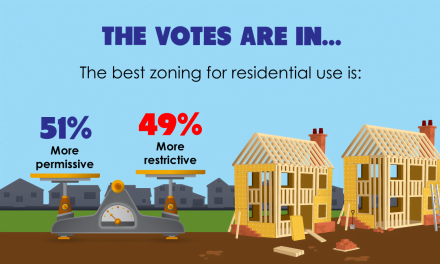Builders batten down the hatches
How is tomorrow’s housing market shaping up? Just ask a builder.
Construction starts began to trail off in the summer months of 2022, signaling the cooling economy has caught up to the construction industry.
The National Association of Homebuilders (NAHB) forecasts 2022 to experience the first annual decline in new construction since 2011, when the housing market was still suffering from the post-Millennium Boom housing bust.
Viewed in another light, today’s reduction in housing starts will continue to constrain inventory, helping to keep home prices and rents elevated despite the slowdown, according to Zillow.
Builders are firmly less optimistic.
Builder sentiment declined for the ninth month in a row in September 2022, according to the NAHB.
Absent the turbulent months of Spring 2020, confidence in the construction industry in September 2022 was at its lowest since 2014. Where an index number of 50 translates to an equal number of builder respondents providing positive and negative responses, builder sentiment plunged to:
- 31 for prospective buyer traffic;
- 46 for future sales expectations; and
- 54 for current sales conditions.
Regionally, the western region of the U.S., which includes California, posted the steepest declines in builder sentiment, with the index falling from 51 in mid-2022 to 41 in September 2022. In other words, the majority of California homebuilders weighed construction industry conditions to be poor.
For reference, builder sentiment overall has dropped 45% from an index number of 84 at the end of 2021.
California’s construction shortage continues
Here in California, residential construction is like water: we need more of it, but the drought endures.
The fact that housing starts continue to remain well below what is needed to meet demand is reflected in the leap in home prices and rents experienced in 2020-2021. When prices rise faster than the rate of incomes, homebuyers and tenants are squashed into a lower quality of life. Of concern to real estate professionals, this leads to lower homeownership rates and reduced transactions.
However, unlike the water shortage, the solution to California’s housing crisis is fairly simple: we need to let builders do their jobs and respond to demand organically.
For years, California’s state legislature has worked to do their part to do just that, through enacting new laws that:
- require local governments to adjust zoning rules to allow for greater density;
- reduce building restrictions in transit- and job-rich areas;
- remove impact fees for low-income housing;
- reduce parking limitations;
- close the door on strategies used by not-in-my-backyard (NIMBY) advocates; and
- enable the California Attorney General to take action against local governments when they don’t follow laws enacted to increase the housing supply.
Related article:
Local governments try to dodge California’s single family zoning ban
But 2022’s issue of declining starts goes beyond NIMBYs and overly restrictive laws. The economic situation is dragging down starts, and the solution won’t be found until the recovery from the undeclared 2022 recession.
Watch for new construction to continue to lag in 2022-2024. Home prices will fall back to the mean price trendline by 2025. When prices decline, recent homebuyers will soon find themselves underwater, weighed down by negative equity. Unable to complete a traditional sale, some of these homes will head toward foreclosure and become real estate owned (REO) properties.
Then, expect a return of real estate speculators to provide a boost during the coming slump, with a sustainable recovery taking off alongside the full return of end user homebuyers around 2026-2027. At this point, builders will begin to regain confidence in the long-term investment which characterizes new construction, and starts will rise toward their next peak.
Stay up to date on all of California’s housing market developments by subscribing to Quilix, the firsttuesday newsletter.













